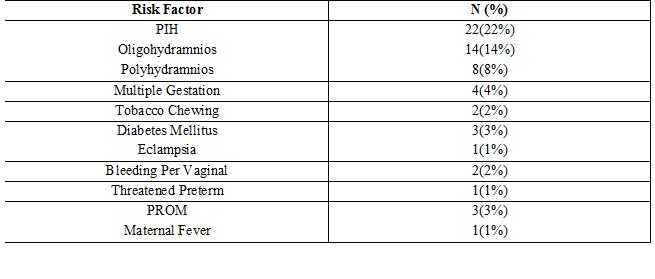Risk factors of birth asphyxia in neonates
Abstract
Background: Perinatal asphyxia is an insult to fetus or newborn due to lack of oxygen (hypoxia) or lack of perfusion (ischemia) to various organ of sufficient magnitude and duration. Perinatal asphyxia is one of the major causes of early neonatal mortality in India.
Objective: To study the risk factors of birth asphyxia in children.
Design: Observational prospective study on babies delivered in our hospital and requiring resuscitation.
Duration: March 2014 to September 2014.
Setting: Department of Paediatrics, Bhaskar Medical College.
Participants: 100 babies delivered in our hospital and requiring resuscitation.
Methods: All neonates who needed resuscitation at birth were included. Maternal obstetric history was taken which included the gravity, parity, abortions and living issues. Mother’s ANC status was asked. Mother’s ABO Blood group and Rh type was taken. History of maternal health conditions was asked for. History of maternal illness was also taken. Neonatal information was entered next which birth weight, term information and others.
Results: The mean age of mothers was 25.3 years. 54% neonates were born to primiparous mothers. Anemia was widely prevalent in the mothers of neonates requiring resuscitation. The maternal risk factors for newborns requiring resuscitation were PIH (22%), oligohydramnios (14%),multiple gestation (4%), PROM (3%), diabetes mellitus (3%) and UTI (5%). One third of neonates requiring resuscitation were born to unbooked mothers. The fetal factors associated with resuscitation of newborns were IUGR (35%), fetal distress (32%), prematurity (31%), MAS (10%) and mal-presentations (4%).
Conclusion: The most common maternal risk factors for newborns requiring resuscitation was PIH followed by oligohydramnios, multiple gestation, PROM, diabetes mellitus and UTI. IUGR was the most common fetal risk factor followed by fetal distress, prematurity, MAS and mal-presentations.
Downloads
References
2. Liu L, Oza S, Hogan D, et al. Global, regional, and national causes of child mortality in 2000-13, with projections to inform post-2015 priorities: an updated systematic analysis. Lancet. 2015 Jan 31;385(9966):430-40. doi: 10.1016/S0140-6736(14)61698-6. Epub 2014 Sep 30.[pubmed]
3. Aslam HM, Saleem S, Afzal R, et al. "Risk factors of birth asphyxia". Ital J Pediatr. 2014 Dec 20;40:94. doi: 10.1186/s13052-014-0094-2.[pubmed]
4. Mohan K, Mishra PC, Singh DK. Clinical profile of birth asphyxia in newborn. Int J Sci Tech. 2013;3:10–19.
5. West BA, Opara PI. Perinatal asphyxia in a specialist hospital in Port Harcourt, Nigeria. Niger J. 2013;40:206–210.
6. Bahubali G, Vishnu BB, Ramachandra R, et al. Antenatal and intrapartum risk factors for perinatal asphyxia: a case control study. CurrPediatr Res. 2013;17:119–122.
7. Sarnat HB, Sarnat MS. Neonatal encephalopathy following fetal distress. A clinical and electroencephalographic study. Arch Neurol. 1976 Oct;33(10):696-705.[pubmed]
8. Deorari AK, Paul VK, Singh M, et al. The National Movement of Neonatal Resuscitation in India. J Trop Pediatr. 2000 Oct;46(5):315-7. doi: 10.1093/tropej/46.5.315.[pubmed]
9. Mondal S, Chaudhuri A, Kamilya G, Santra D. Fetomaternal outcome in obstructed labor in a peripheral tertiary care hospital. Med J DY Patil Univ. 2013;6:146–150.
10. World Health Organization. Managing Prolonged and Obstructed Labour. Education Material for Teachers of Midwifery Education Modules; 2008.
11. Bang AT, Bang RA, Baitule SB, et al. Management of birth asphyxia in home deliveries in rural Gadchiroli: the effect of two types of birth attendants and of resuscitating with mouth-to-mouth, tube-mask or bag-mask. J Perinatol. 2005 Mar;25 Suppl 1:S82-91.[pubmed]
12. Ilah BG, Aminu MS, Musa A, Adelakun MB, Adeniji AO, Kolawole T. Prevalence and risk factors for perinatal asphyxia as seen at a specialist hospital in Gusau, Nigeria. Afr J Med. 2014;2:64–69.
13. Ellis M, Manandhar N, Manandhar DS, de L, Costello AM. Birth remains risky for infants in Kathmandu, Nepal, a developing country: unmatched case-control study. BMJ. 2000;320:1229–1236.
14. Padayachee N, Ballot DE. Outcomes of neonates with perinatal asphyxia at a tertiary academic hospital in Johannesburg, South Africa. S Afr J CH. 2013;7:89–94.
15. Basu P, Som S, Das H, et al. Electrolyte status in birth asphyxia. Indian J Pediatr. 2010 Mar;77(3):259-62. doi: 10.1007/s12098-010-0034-0. Epub 2010 Feb 22.[pubmed]
16. Masood N, tulMuntiha S, Sharif M, Asghar RM. Correlation of serum electrolyte changes with severity of birth asphyxia in newborns. J Rawalpindi Med Col. 2014;20:27–29.
17. Etuk SJ, Etuk IS, Ekott MI, Udoma EJ. Perinatal outcome in pregnancies booked for ante-natal care but delivered outside health facilities in Calabar, Nigeria. Acta Trop. 2000;75:29-33.
18. Akhter S, Momen MA, Rahman MM, et al. Effect of maternal anemia on fetal outcome. Mymensingh Med J. 2010 Jul;19(3):391-8.[pubmed]
19. Dalal CA, Bodar NL. Astudy on birth asphyxia at tertiary health centre. Natl J Med Res. 2013;3:374-6.

Copyright (c) 2018 Author (s). Published by Siddharth Health Research and Social Welfare Society

This work is licensed under a Creative Commons Attribution 4.0 International License.


 OAI - Open Archives Initiative
OAI - Open Archives Initiative


